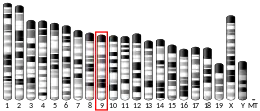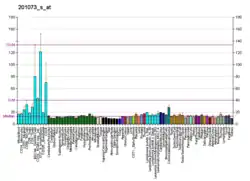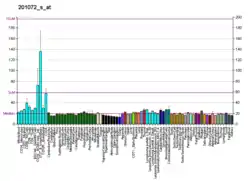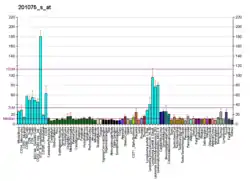SMARCC1
SWI/SNF complex subunit SMARCC1 is a protein that in humans is encoded by the SMARCC1 gene.[5][6]
Function
The protein encoded by this gene is a member of the SWI/SNF family of proteins, whose members display helicase and ATPase activities and which are thought to regulate transcription of certain genes by altering the chromatin structure around those genes. The encoded protein is part of the large ATP-dependent chromatin remodeling complex SWI/SNF and contains a predicted leucine zipper motif typical of many transcription factors.[6]
Interactions
SMARCC1 has been shown to interact with:
References
- GRCh38: Ensembl release 89: ENSG00000173473 - Ensembl, May 2017
- GRCm38: Ensembl release 89: ENSMUSG00000032481 - Ensembl, May 2017
- "Human PubMed Reference:". National Center for Biotechnology Information, U.S. National Library of Medicine.
- "Mouse PubMed Reference:". National Center for Biotechnology Information, U.S. National Library of Medicine.
- Wang W, Xue Y, Zhou S, Kuo A, Cairns BR, Crabtree GR (November 1996). "Diversity and specialization of mammalian SWI/SNF complexes". Genes Dev. 10 (17): 2117–30. doi:10.1101/gad.10.17.2117. PMID 8804307.
- "Entrez Gene: SMARCC1 SWI/SNF related, matrix associated, actin dependent regulator of chromatin, subfamily c, member 1".
- Kitagawa H, Fujiki R, Yoshimura K, Mezaki Y, Uematsu Y, Matsui D, Ogawa S, Unno K, Okubo M, Tokita A, Nakagawa T, Ito T, Ishimi Y, Nagasawa H, Matsumoto T, Yanagisawa J, Kato S (June 2003). "The chromatin-remodeling complex WINAC targets a nuclear receptor to promoters and is impaired in Williams syndrome". Cell. 113 (7): 905–17. doi:10.1016/s0092-8674(03)00436-7. PMID 12837248.
- Kuzmichev A, Zhang Y, Erdjument-Bromage H, Tempst P, Reinberg D (February 2002). "Role of the Sin3-histone deacetylase complex in growth regulation by the candidate tumor suppressor p33(ING1)". Mol. Cell. Biol. 22 (3): 835–48. doi:10.1128/mcb.22.3.835-848.2002. PMC 133546. PMID 11784859.
- Sif S, Saurin AJ, Imbalzano AN, Kingston RE (March 2001). "Purification and characterization of mSin3A-containing Brg1 and hBrm chromatin remodeling complexes". Genes Dev. 15 (5): 603–18. doi:10.1101/gad.872801. PMC 312641. PMID 11238380.
- Wang W, Côté J, Xue Y, Zhou S, Khavari PA, Biggar SR, Muchardt C, Kalpana GV, Goff SP, Yaniv M, Workman JL, Crabtree GR (October 1996). "Purification and biochemical heterogeneity of the mammalian SWI-SNF complex". EMBO J. 15 (19): 5370–82. doi:10.1002/j.1460-2075.1996.tb00921.x. PMC 452280. PMID 8895581.
- Otsuki T, Furukawa Y, Ikeda K, Endo H, Yamashita T, Shinohara A, Iwamatsu A, Ozawa K, Liu JM (November 2001). "Fanconi anemia protein, FANCA, associates with BRG1, a component of the human SWI/SNF complex". Hum. Mol. Genet. 10 (23): 2651–60. doi:10.1093/hmg/10.23.2651. PMID 11726552.
- Zhao K, Wang W, Rando OJ, Xue Y, Swiderek K, Kuo A, Crabtree GR (November 1998). "Rapid and phosphoinositol-dependent binding of the SWI/SNF-like BAF complex to chromatin after T lymphocyte receptor signaling". Cell. 95 (5): 625–36. doi:10.1016/s0092-8674(00)81633-5. PMID 9845365. S2CID 3184211.
Further reading
- Bonaldo MF, Lennon G, Soares MB (1997). "Normalization and subtraction: two approaches to facilitate gene discovery". Genome Res. 6 (9): 791–806. doi:10.1101/gr.6.9.791. PMID 8889548.
- Wang W, Côté J, Xue Y, Zhou S, Khavari PA, Biggar SR, Muchardt C, Kalpana GV, Goff SP, Yaniv M, Workman JL, Crabtree GR (1996). "Purification and biochemical heterogeneity of the mammalian SWI-SNF complex". EMBO J. 15 (19): 5370–82. doi:10.1002/j.1460-2075.1996.tb00921.x. PMC 452280. PMID 8895581.
- Fryer CJ, Archer TK (1998). "Chromatin remodelling by the glucocorticoid receptor requires the BRG1 complex". Nature. 393 (6680): 88–91. Bibcode:1998Natur.393...88F. doi:10.1038/30032. PMID 9590696. S2CID 2208522.
- Ring HZ, Vameghi-Meyers V, Wang W, Crabtree GR, Francke U (1998). "Five SWI/SNF-related, matrix-associated, actin-dependent regulator of chromatin (SMARC) genes are dispersed in the human genome". Genomics. 51 (1): 140–3. doi:10.1006/geno.1998.5343. PMID 9693044.
- Cho H, Orphanides G, Sun X, Yang XJ, Ogryzko V, Lees E, Nakatani Y, Reinberg D (1998). "A Human RNA Polymerase II Complex Containing Factors That Modify Chromatin Structure". Mol. Cell. Biol. 18 (9): 5355–63. doi:10.1128/MCB.18.9.5355. PMC 109120. PMID 9710619.
- Sif S, Stukenberg PT, Kirschner MW, Kingston RE (1998). "Mitotic inactivation of a human SWI/SNF chromatin remodeling complex". Genes Dev. 12 (18): 2842–51. doi:10.1101/gad.12.18.2842. PMC 317164. PMID 9744861.
- Shanahan F, Seghezzi W, Parry D, Mahony D, Lees E (1999). "Cyclin E Associates with BAF155 and BRG1, Components of the Mammalian SWI-SNF Complex, and Alters the Ability of BRG1 To Induce Growth Arrest". Mol. Cell. Biol. 19 (2): 1460–9. doi:10.1128/mcb.19.2.1460. PMC 116074. PMID 9891079.
- Phelan ML, Sif S, Narlikar GJ, Kingston RE (1999). "Reconstitution of a core chromatin remodeling complex from SWI/SNF subunits". Mol. Cell. 3 (2): 247–53. doi:10.1016/S1097-2765(00)80315-9. PMID 10078207.
- Kowenz-Leutz E, Leutz A (2000). "A C/EBP beta isoform recruits the SWI/SNF complex to activate myeloid genes". Mol. Cell. 4 (5): 735–43. doi:10.1016/S1097-2765(00)80384-6. PMID 10619021.
- Bochar DA, Wang L, Beniya H, Kinev A, Xue Y, Lane WS, Wang W, Kashanchi F, Shiekhattar R (2000). "BRCA1 is associated with a human SWI/SNF-related complex: linking chromatin remodeling to breast cancer". Cell. 102 (2): 257–65. doi:10.1016/S0092-8674(00)00030-1. PMID 10943845. S2CID 6500100.
- Kadam S, McAlpine GS, Phelan ML, Kingston RE, Jones KA, Emerson BM (2000). "Functional selectivity of recombinant mammalian SWI/SNF subunits". Genes Dev. 14 (19): 2441–51. doi:10.1101/gad.828000. PMC 316972. PMID 11018012.
- Xue Y, Canman JC, Lee CS, Nie Z, Yang D, Moreno GT, Young MK, Salmon ED, Wang W (2001). "The human SWI/SNF-B chromatin-remodeling complex is related to yeast Rsc and localizes at kinetochores of mitotic chromosomes". Proc. Natl. Acad. Sci. U.S.A. 97 (24): 13015–20. Bibcode:2000PNAS...9713015X. doi:10.1073/pnas.240208597. PMC 27170. PMID 11078522.
- Sif S, Saurin AJ, Imbalzano AN, Kingston RE (2001). "Purification and characterization of mSin3A-containing Brg1 and hBrm chromatin remodeling complexes". Genes Dev. 15 (5): 603–18. doi:10.1101/gad.872801. PMC 312641. PMID 11238380.
- Otsuki T, Furukawa Y, Ikeda K, Endo H, Yamashita T, Shinohara A, Iwamatsu A, Ozawa K, Liu JM (2002). "Fanconi anemia protein, FANCA, associates with BRG1, a component of the human SWI/SNF complex". Hum. Mol. Genet. 10 (23): 2651–60. doi:10.1093/hmg/10.23.2651. PMID 11726552.
- Kato H, Tjernberg A, Zhang W, Krutchinsky AN, An W, Takeuchi T, Ohtsuki Y, Sugano S, de Bruijn DR, Chait BT, Roeder RG (2002). "SYT associates with human SNF/SWI complexes and the C-terminal region of its fusion partner SSX1 targets histones". J. Biol. Chem. 277 (7): 5498–505. doi:10.1074/jbc.M108702200. PMID 11734557.
- Nie Z, Yan Z, Chen EH, Sechi S, Ling C, Zhou S, Xue Y, Yang D, Murray D, Kanakubo E, Cleary ML, Wang W (2003). "Novel SWI/SNF Chromatin-Remodeling Complexes Contain a Mixed-Lineage Leukemia Chromosomal Translocation Partner". Mol. Cell. Biol. 23 (8): 2942–52. doi:10.1128/MCB.23.8.2942-2952.2003. PMC 152562. PMID 12665591.
- Kitagawa H, Fujiki R, Yoshimura K, Mezaki Y, Uematsu Y, Matsui D, Ogawa S, Unno K, Okubo M, Tokita A, Nakagawa T, Ito T, Ishimi Y, Nagasawa H, Matsumoto T, Yanagisawa J, Kato S (2003). "The chromatin-remodeling complex WINAC targets a nuclear receptor to promoters and is impaired in Williams syndrome". Cell. 113 (7): 905–17. doi:10.1016/S0092-8674(03)00436-7. PMID 12837248.
- Hsiao PW, Fryer CJ, Trotter KW, Wang W, Archer TK (2003). "BAF60a Mediates Critical Interactions between Nuclear Receptors and the BRG1 Chromatin-Remodeling Complex for Transactivation". Mol. Cell. Biol. 23 (17): 6210–20. doi:10.1128/MCB.23.17.6210-6220.2003. PMC 180928. PMID 12917342.
This article is issued from Wikipedia. The text is licensed under Creative Commons - Attribution - Sharealike. Additional terms may apply for the media files.






